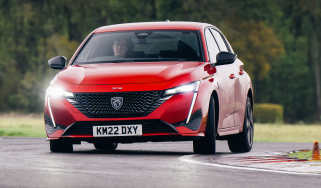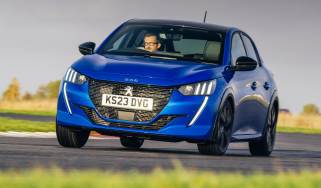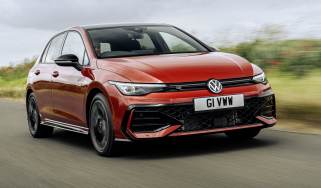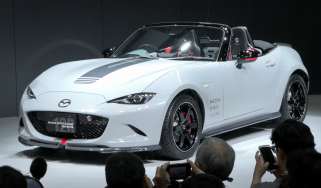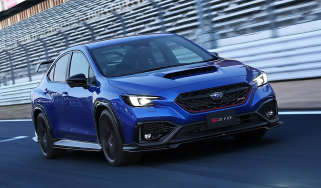Mini Cooper and Cooper S (R50/R53, 2001 - 2006): review, specs and buying guide
The R50 Mini Cooper captured all the fun of the original with excellent dynamics and a charming design, making it one of our top 25 cars of the last 25 years
The launch of the original BMW Mini Cooper was a very different affair to your regular German event. The conference room was more like a nightclub, a heavily Mini-themed space, bold and black as the showrooms would be, and populated by tie-less executives. The car we would soon drive on the roads near Perugia in Umbria, Italy, was even more surprising. As its designer Frank Stephenson later said, the Germans were terrified that they’d mess up and kill a British icon. They didn’t, they knocked it out of the park.
It wasn’t the first retro-inspired car. Volkswagen had already reimagined the Beetle but it wasn’t wildly successful, perhaps because it was cartoonish rather than a cool take on the classic. The Mini looked dynamic and an evolution of the original; you could imagine there being a couple of earlier models, design stepping stones leading to the R50, as the new Mini was known internally.
Refreshingly new yet reassuringly familiar, its design self-confident and fun. It was bejewelled with bespoke details, like the chrome-rimmed lights front and rear, and the large, central speedo and row of rally car-style toggle switches, another nod to the original. Its wide-track, wheel-at-each-corner stance promised keen dynamics, particularly as it was underpinned by a technically sophisticated chassis: up front it had MacPherson struts like its supermini rivals but at the rear it had a version of the BMW multi-link Z-axle when most rivals had a twist beam or something similarly simple. And yet the Cooper was priced £200 less than its keenest rival, the Peugeot 106 GTi.
The Cooper was a gem; desirable before you drove it, a must-have once you had. Its dynamics were oddly reminiscent of the original’s, the ride short-legged but absorbent, the handling agile yet resolutely stable. It felt so unshakably planted, so foolproof, that I broke the first rule of road testing: never let the photographer drive (particularly when you’re in the car). A few minutes later, on a high, narrow road whose parapet seemed more for decoration than effect, we barrelled into a corner at wildly ambitious speed and screeched to a halt with millimetres to spare. Had it been a 106 GTi, our favourite supermini at the time… well, I probably wouldn’t have given up the driver’s seat in the first place.
History shows that BMW was bang on the money insisting that the new Mini be a fun-to-drive, upmarket car rather than the utilitarian replacement for the Metro/Rover 100 that the Brits had wanted. Meanwhile, the trim packs offered – Salt, Pepper and ‘Chili’ – were just the start of personalisation options that would add greatly to both the Mini’s appeal and BMW’s profits and prompt imitations from other car makers.
The ability to have a Union flag on your roof, or to stand out with some stripes, was something a bit different at the time. It’s possible to argue that the phenomenal Porsche ‘paint to sample’ trend and the lucrative businesses that are MSO (McLaren), Ad Personam (Lamborghini) and Q (Aston Martin) all have Mini to thank for kickstarting the modern obsession with having something unique.
> 2025 Mini Convertible is petrol only for now
More than two decades on, meeting an early car – one of the first 200 UK cars, no less – it’s striking how small it looks. Back in 2001, we were agog at just how much bigger the new MINI (as BMW wanted it written) was compared to the Issigonis original, but today it looks dinky: small, neat, with minimal overhangs, which you just don’t see on new cars any more. In fact, as Stephenson recounted, according to the engineers, at 3.6m long the R50 Mini was as small as it could be with the chosen drivetrain and still make the five-star safety rating for the US market.
This car has been owned by Martyn Collins for over six years now. He picked it up for about £1k when they weren’t that valued and it’s now worth about £6k, which seems appropriate given its historical value. He invested a fair bit restoring it before the stock of the earliest examples started rising, even though some of the bills to keep them going can be eyewatering, particularly for major items like air conditioning units, while some other parts just aren’t available. But Collins’ enthusiasm runs deep because the Mini came out the first year he became a motoring journalist, so for him it has an emotive and historical significance.
Collins’ Cooper is car 122 from that first batch of press cars, though it didn’t actually see service on the press fleet. All were Y reg and there’s a register for these 2001-built cars called The Y REGister, of course. Those first 200 were pre-production cars, as evidenced by some non-production details, including this car’s rare, round pedal rubbers that are embossed with ‘MINI’ and look like they’ve come off a vintage car. There’s a BMW-marked filler cap and the seats are non-standard, with a central channel running down the squab and cushion. It’s an odd spec too, being part Chili Pack: it has white painted wheels and a white roof and door mirrors but no rear spoiler.
At launch, the price was a wow – just £11,600 for the Cooper, which looked amazing value for money. And it was, unless you were tempted by the options, which we at evo were. We pulled a few strings to get an early car (Y362 MGM) and found ourselves with a long-termer that cost almost £15k. It was an experience that would be repeated in Mini showrooms the world over.
> Powerflex Mini V8 2025 review – driving a BMW M3-powered hatch
Our big-ticket items were the Chili pack (£1000), air con (£600), full leather (£530), electric glass sunroof (£500) and metallic paint (£250). It wasn’t a fault-free experience. The leather seat trim we paid extra for was so awful we had it re-upholstered by a specialist, and the seat tilt and slide mechanism was problematic too. There were other niggles that took a while to iron out in production, but even so demand for the new Mini was so great you could get your money back having run it for a year.
The Cooper romped to victory in its first evo group test (issue 034) even though it didn’t hit the sensational, athletic heights of the Peugeot 106 GTi’s handling. The Mini was heavier (1050 v 950kg) and a little less powerful (113 v 120bhp) giving it a less sparkling power-to-weight ratio, and longer gearing further dimmed that sparkle – it ran to 90mph in third. The engine BMW chose to fit didn’t zing with enthusiasm either.
Under the clamshell bonnet was the joint venture Tritec or Pentagon 1.6-litre ‘four’. This clean-sheet design, developed in conjunction with Chrysler, was an iron-block, single-cam, 16-valve engine built in Brazil. It appeared to offer nothing over the all-aluminium, twin-cam K-series that was built next door to the Mini factory and had already paid back its development costs… except that it fitted under the bonnet. In some markets there was a 1.4-litre Tritec for the Mini One, but in the UK it was the same 1.6 as in the Cooper but fitted with a different ECU that simply restricted the throttle opening to cap power at 90bhp. For a few hundred quid you could get an aftermarket chip that gave full throttle and better-than-Cooper power.
It’s been many years since I’ve sat in an original BMW Mini, and the cockpit that was so amazing back then isn’t quite so stunning now. Not because it’s a bit worn in places but because Mini cockpits, particularly their facias, have only got more dramatic, the central dial growing from the size of a saucer to the size of a dinner plate. Interior space wasn’t the major objective that it was in the classic Mini with its external body seams, but while it’s cramped in the rear of an R50 it’s roomy up front and the driving position is excellent, with steering wheel, seat and pedals all aligned – not always the case in small cars.
Collins has fitted a K&N filter, which is a good thing because now there’s some intake bark to smother the general thrash of the workman-like Tritec engine, which you have to work hard to get the performance that the looks and chassis of the Cooper deserve. Two decades on, performance feels a bit thin. I don’t think this car is down on power, it’s just that the near-total roll-out of turbocharging in the intervening years has conditioned us to expect generous, readily available torque. The supercharged Cooper S was just around the corner, of course, and its 163bhp would satisfy the power-hungry and give the chassis a proper workout.
The chassis of Collins’ Cooper has been well fettled; it’s had new brakes, new dampers and all of the suspension bushes have been replaced with Powerflex items. It feels pretty tight and within a mile it all comes flooding back: the lovely demeanour, the way all the weight feels low-slung like it’s underneath your seat, the solid way the car rides on a good road and how it feels a bit short-travelled on a choppy road but is still compliant so you can keep your toe in.
It was surely no coincidence, given that so much else about the R50 is inspired by the original Mini, that the dynamics seemed to be too, and the aural character; there’s even a little gear whine. The gearshift is as sweet as, though. I don’t remember it being this good even when it was new. Collins has replaced the gearbox oil at every engine oil service, which helps apparently (his Cooper has over 100,000 miles on the clock). The shift feels slick, as though any sharp edges in the gate have been worn smooth so the lever slips between ratios with a lovely, polished action.
The car I drove on the launch was on 15-inch wheels, which was a decent diameter for a supermini back then, though they were shod with very modest tyres, mere 175/65s, and not sporty rubber either, just your everyday Pirelli P3000 Energy. Our long-termer had 16-inch rims that wore much wider and lower-profile Goodyears – 195/55s – that made the steering so direct you had to slow your inputs to stop the car feeling nervy, which is why I preferred it on the 15s. There was still plenty of grip and the car’s poise was just as unflappable, but it was more easy-going. You were still encouraged to carry speed into the corners to maintain momentum – just lift off and turn in.
It’s marvellous to get into a Cooper all these years later and rediscover those traits. The steering wheel is quite big, the response to inputs not especially sharp, but you feel on top of the mass of the car and sort of direct things as it zips around corners. It’s a well-worn cliché but it’s almost like you’re driving a go‑kart. It’s so very biddable that you don’t have to use the brakes, you just chuck it in and scrub off speed when you need to.
This example is taut and grips well on its 16-inch rims and tyres – a newly acquired set of Falken runflats – but there’s a bit more steering effect, a bit more rotation than you expect. I suspect that the suspension alignment is a little out, maybe at the rear where the camber looks a bit off. Whatever, there’s a bit more response than you’re expecting when you bung it into a turn, not lift-off oversteer in the classic sense, just enough to make you take notice and adjust your inputs accordingly. I quite like it. It feels like how the Mini might have been set up if it had been down to a Peugeot engineer. What I would like is more lateral support from the seats; they’re comfy enough, you just want to be held in place better when you’re bombing around.
The basics of a great driver’s car were there in the Mini right from the start – the short wheelbase and wide tracks, the sophisticated suspension, the low centre of gravity. More powerful versions exploited this, the supercharged Cooper S delivering the grunt that the Cooper lacked, while the Eaton Roots-type ’charger added a further, nostalgic dollop of what sounded like gear whine. Then in 2006 the Cooper S Works GP came along to stretch the supermini boundaries with its greater focus, seatless rear and pared equipment. Collins has one of those tucked away too.
The same year saw the introduction of the second-generation BMW Mini, the R56. The three-door hatch kept the faith, increasing in size only very slightly in a redesign to meet new pedestrian impact safety standards, the main visual being a slightly higher waistline. The essential terrier-like character survived and there was a feistier John Cooper Works GP model and the unusual Coupé, which looked like the hatch wearing a beret.
Using old Mini names with new definitions was an interesting development. The first Clubman I found intriguing. It was an obvious and useful extension of the range and appealingly odd, being an estate with twin rear doors instead of a hatch, and equipped with a teeny side door (the ‘club door’). It even spawned a panel van – the Clubvan – which I seriously contemplated as a daily driver. It wasn’t that space efficient but I wanted it more for the look and the tax saving.
However, from there things started to slide, with other models seeming to forget they were Minis. First there was the challenging shape of the taller, uglier Countryman crossover, which was available in front- or four-wheel drive, and even in Cooper S and John Cooper Works trims. A colleague summed it up perfectly when he said: ‘Mini fanboys call the Clubman the “Clubby”. What are they going to call the Countryman?’
Spun from this was the Paceman, a high-riding three-door with a tapering roofline. Mini’s Evoque. Then in 2014 the third-generation hatch, the F55, arrived, upscaled in all directions to comply with more stringent impact and intrusion legislation. Sharing its platform with the 2-series BMW, it was bigger and lost the tightness of Stephenson’s original design. Its dynamics went the same way. The accompanying new Clubman was a bloated, long-wheelbase, six-door estate (two each side, two at the rear), while the updated Countryman was oddly bluff, looking like it had swallowed a small shipping container.
Mini's third-generation Countryman is now here, with adverts describing it as being ‘The BIGGEST dose of MINI‑NESS EVER’ (their capitals), which I can’t help thinking is an oxymoron. Compared to Stephenson’s Mini, it’s almost a quarter of a metre taller, a metre longer and weighs over 1600kg, making it a whopping 570kg heavier. Mini my arse.
These definition-stretching Minis only make the originals even more attractive and collectable. It’s been great to make the original Cooper’s acquaintance again more than 20 years on and discover that not only does it now feel properly small, but also that it’s still loaded with character and is capable and properly entertaining. The earliest cars are not without their issues but if you buy well you’ll have yourself a car that’s inexpensive, stylish and entertaining. The Cooper is a proper evo car and a fully-fledged icon.
Specs
| Cooper | Cooper S | Cooper S Works GP | |
| Engine | 1598cc, in-line 4cyl | 1598cc, in-line 4cyl, supercharged | 1598cc, in-line 4cyl, supercharged |
| Max power | 113bhp @ 6000rpm | 168bhp @ 6000rpm | 215bhp @ 7100rpm |
| Max torque | 110lb ft @ 4500rpm | 155bhp @ 4000rpm | 184lb ft @ 4600rpm |
| Weight | 1050kg | 1140kg | 1090kg |
| Power-to-weight | 109bhp/ton | 143bhp/ton | 200bhp/ton |
| 0-62mph | 9.2sec (claimed) | 7.2sec (claimed) | 6.5sec (claimed) |
| Top speed | 124mph (claimed) | 135mph (claimed) | 149mph (claimed) |
Henry Catchpole on the Mini R50: 'I owned one for several years'
'RE51 DMO – red, white roof, Pepper pack, 15‑inch alloys, no air con – was my first proper evo car and I loved it. I bought it (three years before I joined the magazine) nearly new and when they were still a relatively rare sight on the roads, which meant it attracted a huge amount of attention. In fact, for £11,000 I had a supermini that was as eye-catching as a supercar, which was quite extraordinary. Not that attention-seeking was the reason I bought it.
'What sealed the deal for me, was seeing the Mini (an evo subs desk decision was made early on not to follow BMW’s style guide and go all-caps MINI) in that year’s eCoty, duking it out in Tuscany alongside cars like the Vanquish, Zonda, and Murciélago. It wasn’t put in the shade, either, with Peter Tomalin writing ‘it feels special, even in Italy and even in this company’. In the end it finished 10th out of 12, which might sound a bit ho-hum. However, of the two cars it beat, one was the Clio 172, which was a huge scalp to take for a car like the Mini with just 113bhp.
'The engine was never much to write home about but, as with most of the car, its slightly convoluted history makes its ultimate success all the more remarkable. When the new Mini was a Rover (the R in R50) project, a K-series was pencilled-in under the bonnet, but BMW switched this for a cheap, iron-block, 1.6-litre four-cylinder that was developed with Chrysler and built in Brazil. Much of the final work on the car, including the engine, was actually done by ex-Rover employees who had been moved to Ricardo when BMW sold the company.'
What we said
Mini Cooper, evo 033 (Jul 01), John Barker
‘It’s a pretty ordinary sounding engine, reasonably refined at tickover and tight and together up to 5000rpm. Throttle response is clean – if you didn’t know, you’d never guess it was drive-by-wire – but there’s not much edge to its low speed delivery… I’d be surprised if the Cooper cracked nine seconds to 60mph, and it would be a pretty raucous affair because at the top end the engine becomes rather thrashy.
‘It’s a shame the Cooper isn’t more gutsy because it’s every bit as chuckable and poised as you’d hope. It feels good the moment you pull away, with a solid, big-car feel and the encouraging sense that all the weight is concentrated below hip level. The Cooper rides rough sections with sporting suppleness, letting you feel connected but filtering out the sharp edges, and it flicks from camber to camber, apex to apex, with a precision and composure that inspires trust.’
Mini Cooper S, evo 043 (May 02), John Barker
‘With its considerable torque advantage, the Cooper S hauls through the lower gears with much more conviction, of course, but a close-ratio ‘box would surely have suited it better. Even so, BMW claims the S hits 62mph in 7.4sec and, to be honest, it feels good for it.
‘That’s the thing about the Cooper S: you expect more low-rev urgency, you think it should have shorter gearing, and yet at the end of a long day spent thrashing it up and down some great roads, you can’t help but conclude that it’s a superb little car that’s a whole heap more satisfying than the stock Cooper.
‘Steer into a turn and the S seems to pivot around a stake driven through the centre of the dashboard, biting into the road and slicing hard for the apex. There’s no obvious roll, no slip, the car just turns.’
Mini Cooper S Works GP, evo 094 (Aug 06), Jethro Bovingdon
‘At low speeds it’s familiar Mini: quick steering, strong torque, stiff, flat ride. Over ragged tarmac, the GP shows some subtle differences. It’s still firm but somehow it feels more rounded, less likely to skip over sharp ridges and bounce the car off line. Sounds great, too. The 1.6-litre supercharged engine revs with all the intensity of a little screamer, but the strong torque means you don’t have to stir the sweet-shifting six-speed ‘box to make quick progress.
‘There’s a bit more roll than I’d expected, but that allows the 205/40 Dunlops’ treadblocks to lock into the surface and hook the nose into the apex. Jump on the power as you feel it settle and the standard limited-slip diff transmits all 218bhp to the road with immense composure, steering wheel gently writhing in your hands.’
What to pay
| Mini Cooper (R50) | Mini Cooper S (R53) | |
| Excellent | £7000 | £12,000 |
| Good | £4000 | £6000 |
| Average | £2800 | £4500 |
| Project | £800 | £1300 |



